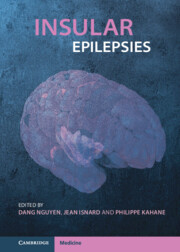Book contents
- Insular Epilepsies
- Insular Epilepsies
- Copyright page
- Contents
- Contributors
- Foreword
- Chapter 1 A Brief History of Insular Cortex Epilepsy
- Section 1 The Human Insula from an Epileptological Standpoint
- Chapter 2 Anatomy of the Insula
- Chapter 3 Vascularization of the Insula: Key Points for Safe Epilepsy Surgery
- Chapter 4 Structural Connectivity of the Insula
- Chapter 5 Functional Connectivity of the Insula
- Chapter 6 Interoceptive Integration in the Primate Insular Cortex
- Section 2 The Spectrum of Epilepsies Involving the Insula
- Section 3 Noninvasive Investigation of Insular Epilepsy
- Section 4 Invasive Investigation of Insular Epilepsy
- Section 5 Surgical Management of Insular Epilepsy
- Index
- References
Chapter 5 - Functional Connectivity of the Insula
from Section 1 - The Human Insula from an Epileptological Standpoint
Published online by Cambridge University Press: 09 June 2022
- Insular Epilepsies
- Insular Epilepsies
- Copyright page
- Contents
- Contributors
- Foreword
- Chapter 1 A Brief History of Insular Cortex Epilepsy
- Section 1 The Human Insula from an Epileptological Standpoint
- Chapter 2 Anatomy of the Insula
- Chapter 3 Vascularization of the Insula: Key Points for Safe Epilepsy Surgery
- Chapter 4 Structural Connectivity of the Insula
- Chapter 5 Functional Connectivity of the Insula
- Chapter 6 Interoceptive Integration in the Primate Insular Cortex
- Section 2 The Spectrum of Epilepsies Involving the Insula
- Section 3 Noninvasive Investigation of Insular Epilepsy
- Section 4 Invasive Investigation of Insular Epilepsy
- Section 5 Surgical Management of Insular Epilepsy
- Index
- References
Summary
This chapter is about the use of direct electrical stimulation with short current pulses to estimate from recorded SEEG responses the functional connectivity of the insula. First, we review some studies of the literature which reported both intra-insular and extra-insular connectivity, using the anterior-posterior gyral decomposition of the insula. Second, we present the mapping of the responses to insula stimulation from 301 patients explored in SEEG from the database of the F-TRACT project. We show that the SEEG responses are highly spatially resolved on the whole brain, as demonstrated when comparing the stimulations between the anterior and posterior parts of the insula at different spatial resolution of the Lausanne parcellation scheme. In general, the responses to electrical stimulation of the insula are particularly numerous, in comparison to the stimulation of other areas, which suggests that insula is a structure densely connected to the rest of the cortex.
Information
- Type
- Chapter
- Information
- Insular Epilepsies , pp. 40 - 51Publisher: Cambridge University PressPrint publication year: 2022
References
Accessibility standard: Unknown
Why this information is here
This section outlines the accessibility features of this content - including support for screen readers, full keyboard navigation and high-contrast display options. This may not be relevant for you.Accessibility Information
- 1
- Cited by
